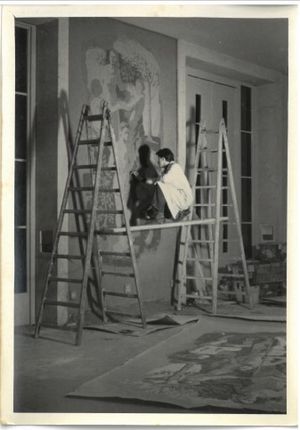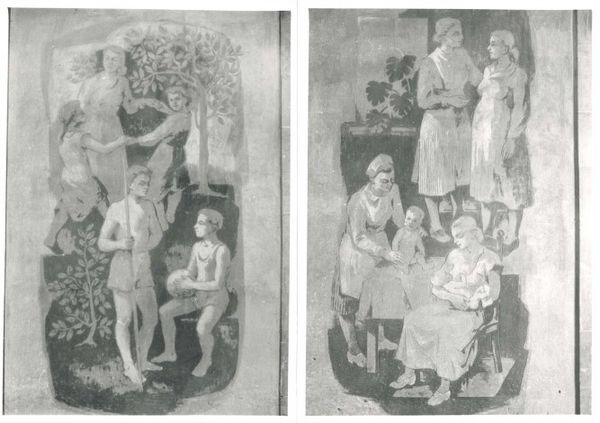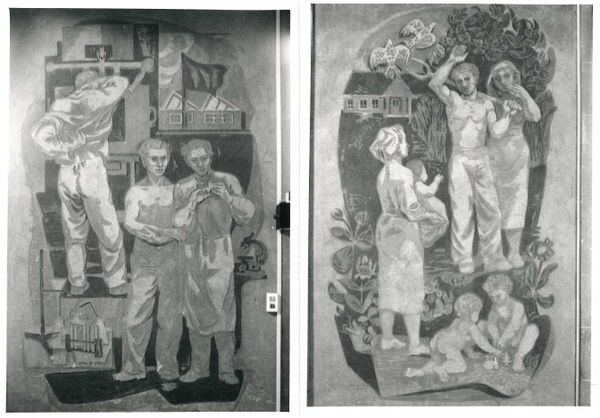
The sgraffiti no longer visible in the vestibule are in fact the result of diploma projects by two students of the Dresden Academy of Fine Arts from 1955. They were supported by the now world-renowned painter Gerhard Richter, who would also submit a diploma project for display at the Hygiene-Museum just one year later – namely the mural entitled Lebensfreude [Joie de Vivre], which today is on show in the south foyer stairwell following its partial uncovering.
The scenes depicted in the sgraffiti take up themes relating to health, prevention and healthy living, which played a pivotal role in the Museum's exhibition remit. The motifs refer to East Germany’s political guiding principle of collectivism and feature idealised images of a socialist society.
In the first mural, Rudolf Lipowski considers the theme of pregnancy and child welfare during infancy. Next to the mother, society too plays a central role and is symbolised by the presence of a nurse. The second depiction, also by Lipowski, addresses family life and the role of the father and the mother in education, particularly with regard to a healthy lifestyle through games and sports.
Before Rudolf Lipowski (born 1927) began studying at the Dresden Academy of Fine Arts in 1951, he had already completed an apprenticeship as a decorative painter and worked as a sign writer in advertising until 1951. He has been living and working as a freelance painter and graphic artist in Pirna-Copitz near Dresden since 1956.
In the third picture, Rudolf Sitte depicts occupational health & safety in East Germany. Doctors were often assigned to companies on a permanent basis and conducted regular check-ups and vaccination campaigns. In the fourth picture, Sitte shows both parents at work. Back then, children were often cared for full-time in nurseries and kindergartens from the age of just a few months.
Rudolf Sitte (1922 – 2009) was a brother of the renowned painter Willi Sitte. In 1958, he became a founding member of the Kunst am Bau [art-in- architecture] visual artists’ production co-operative. He worked at the University of Industrial Design in Halle, Burg Giebichenstein, until 1975. From 1981 to 1987, he held the professorship in architecture-based artistic design at the Dresden Academy of Fine Arts.
Sgraffito as a painting technique
Sgraffito is a wall painting technique not unlike fresco painting in that it requires the presence of several layers of plaster rendering. The four murals in the Museum’s vestibule were most probably created using three superimposed layers, each of a different colour and worked with different tools. The principle of this particular craft is to etch away at the superimposed layers in various areas and/or textures. This weather-resistant technique was traditionally used on the façades of buildings, first and foremost.
The whereabouts of the murals
As part of the general refurbishment (2000 to 2011) by the Dresden-based Peter Kulka architectural firm, the museum building was largely restored to its condition when presented by the architect Wilhelm Kreis at its opening in 1930. The Saxon State Office for the Preservation of Historical Monuments examined which of the building alterations and design changes made between 1945 and 1990 were to be preserved. In this instance, it was decided, after expert examination and documentation, that the sgraffiti could be covered up so that the original appearance of the entrance hall could be reinstated. This principle was in part abandoned during other subsequent interventions, such as the lions by August Gaul in the vestibule or the glass windows by Richard Morgenthal in the stairwell.


